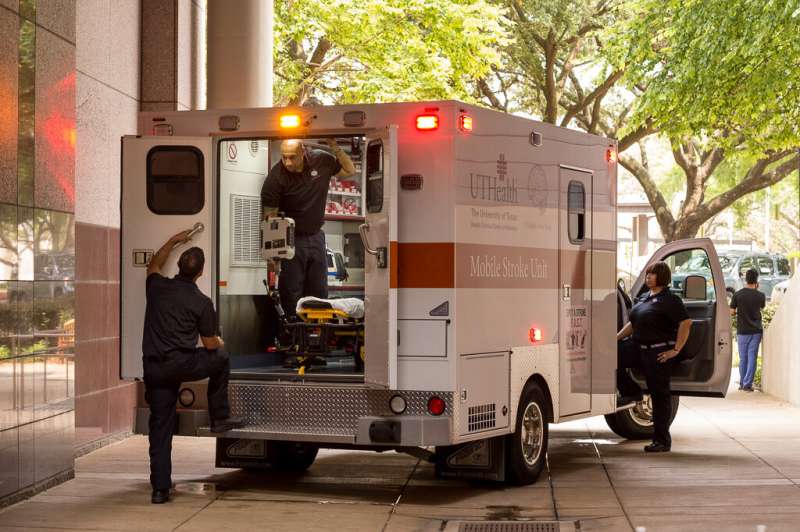
Ischemic stroke patients treated on a mobile stroke unit (MSU) received anti-clot medication faster and ended up with less disability at 90 days, according to a study published today in the New England Journal of Medicine led by researchers at The University of Texas Health Science Center at Houston (UTHealth Houston) and Memorial Hermann-Texas Medical Center.
“The study revealed that for every 100 patients treated with an MSU rather than by standard ambulance, 27 will have less final disability and 11 more will be disability-free,” said James C. Grotta, MD, one of three co-primary authors on the study, director of stroke research at the Clinical Institute for Research and Innovation at Memorial Hermann-TMC, and founder and director of the Houston Mobile Stroke Unit Consortium.
Study results revealed that patients treated on an MSU were more likely to receive the clot-busting drug tissue plasminogen activator (tPA) – 97% compared to 80% with an emergency medical services (EMS) ambulance, and more likely to receive it in the first hour after a stroke. Mortality at 90 days was 9% for MSU versus 12% for EMS.
“Stroke affects an entire family, not just the patient,” said Stephanie Parker, MHA, BSN, RN, co-primary author and manager of the UTHealth Mobile Stroke Unit Program. “That’s why it’s so important to find ways to decrease a patient’s disability and improve their quality of life.” Parker is with the Department of Neurology in McGovern Medical School at UTHealth Houston.
The study began in 2014 with the launch of the UTHealth Mobile Stroke Unit, the first MSU in the country, through a unique partnership with the Houston Fire Department and other local fire departments, as well as hospitals throughout the Texas Medical Center. The unique clinical trial compared outcomes for alternate weeks of service by the MSU or EMS.
Mobile stroke units are special ambulances equipped with a computed tomography (CT) scanner and are staffed by personnel trained to diagnose and treat stroke patients in the pre-hospital setting, including paramedics, a CT technologist, and a critical care nurse. A neurologist is available either onboard or via telemedicine.
“If mobile stroke units are more widely adopted, this could have a large impact on public health by changing the practice of pre-hospital care,” said Jose-Miguel Yamal, Ph.D., co-primary author and lead of the data coordinating center for the trial. “As we have learned in this trial, close integration and collaboration with the local emergency management systems is integral to the success of mobile stroke units. Embedding mobile stroke units into the EMS system has a huge pay off by being able to treat more stroke patients in those first critical hours after stroke.” Yamal is professor of biostatistics and director of the Coordinating Center for Clinical Trials within UTHealth Houston School of Public Health.
“One of the things I am most proud of here in Houston is that an important study could be done that integrated the medical community and fire department,” said David Persse, MD, medical director of the Houston Fire Department-Emergency Medical Services. “That took a tremendous amount of integration and trust and one really important part was the Houston Mobile Stroke Unit Consortium.”
The trial, which ran from 2014 to 2020 and enrolled more than 1,500 patients, eventually expanded across the country to include six additional sites: University of Tennessee in Memphis; New York Presbyterian (Weill Cornell and Columbia University); Indiana University Health; Sutter Health in Burlingame, California; University of California-Los Angeles; and University of Colorado-Anschutz Campus in Aurora and Colorado Springs, Colorado.
Initially, the UTHealth Mobile Stroke Unit carried a vascular neurology specialist on board, with Grotta; Ritvij Bowry, MD; and other UTHealth neurologists rotating the duty. A subsequent study published in 2017 showed that telemedicine could replace the neurologist on board the MSU, which lowered costs.
A comparison of health care resource utilization is currently being analyzed.
“More widespread deployment of mobile stroke units may have a major public health impact on reducing disability from stroke,” said Grotta, who is a member of the UTHealth Institute for Stroke and Cardiovascular Diseases. “Although mobile stroke units are costly to equip and staff, they reduce the time to treatment, and we expect that mobile stroke units will reduce the need for downstream utilization of long-term care.”
Bowry was a stroke fellow at UTHealth when the MSU was unveiled. He is now a neurologist who specializes in neurocritical care within the Department of Neurology and Vivian L. Smith Department of Neurosurgery at McGovern Medical School and senior author on the study.
Source: Read Full Article
